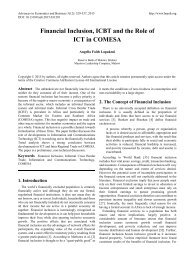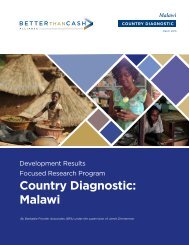FD
gvti301SEaf
gvti301SEaf
You also want an ePaper? Increase the reach of your titles
YUMPU automatically turns print PDFs into web optimized ePapers that Google loves.
Radelet, corrected 04/19/20106<br />
AFRICA<br />
ment gains (see Chart 1). Since 1995<br />
GDP growth across the continent has<br />
averaged about 4.3 percent a year, fully<br />
3 percentage points higher than in the<br />
previous two decades. But it would be<br />
misleading to suggest that rapid growth<br />
rates were universal across the continent.<br />
They varied widely, with about half<br />
the countries in the region moving forward<br />
and others changing little. In the<br />
20 fastest growing countries—excluding<br />
oil exporters—GDP growth averaged<br />
a robust 5.8 percent for two decades,<br />
and real incomes per person more than<br />
doubled. But in other countries, growth<br />
was much slower, and in eight countries,<br />
Chart 1<br />
income per person actually fell. Some of the differences are<br />
stark: in Rwanda real income per person more than doubled; in<br />
Zimbabwe it fell 30 percent.<br />
Where growth accelerated, poverty finally began to fall. The<br />
share of people living in extreme poverty (less than $1.90/day<br />
in constant 2011 prices) dropped from 61 percent in 1993 to<br />
43 percent in 2012, a decline of nearly 1 percentage point a<br />
year for two decades. In some countries (for example, Senegal),<br />
poverty declined even more; in others (Democratic Republic of<br />
the Congo), not at all.<br />
The gains in health were even bigger. Since the mid-<br />
1990s the share of children dying before their fifth birthday<br />
has fallen more than half, from 17 percent to 8 percent.<br />
Remarkably, every single country in sub-Saharan Africa has<br />
reduced child mortality in the past two decades. Malaria<br />
deaths have fallen by half, and deaths related to HIV/AIDS<br />
and tuberculosis have both fallen by one-third. More than<br />
three-quarters of children are enrolled in primary school, up<br />
from just half in the 1980s. More than two-thirds of girls now<br />
complete primary school, which will increase their earning<br />
potential; equally as important, it means that they will have<br />
Two decades of development progress<br />
Incomes have grown, poverty has fallen, and child mortality has declined in sub-Sarahan<br />
Africa.<br />
(GDP per capita, constant 2011 U.S.<br />
dollars, using purchasing-power- (percent of population living on (mortality rate for children<br />
parity prices) less than $1.90/day) under five years old, percent)<br />
4,000<br />
80<br />
20<br />
3,000<br />
2,000<br />
1,000<br />
0<br />
60<br />
40<br />
20<br />
0<br />
0<br />
1994 2014 1994 2014 1994 2014<br />
Source: World Bank, World Development Indicators.<br />
fewer children and that those children will be healthier and<br />
better educated (see “In the Driver’s Seat” in this issue of<br />
F&D). These trends bode well for the future, as they signal<br />
the beginnings of a strong human capital skills base.<br />
Four key forces helped propel the resurgence in the countries<br />
that moved forward.<br />
First, there was a marked improvement in governance, at<br />
least in many countries. According to the U.S. think tank<br />
Freedom House, the number of electoral democracies in<br />
Africa has jumped from just four in 1990 to 23 today. With<br />
democracy came better governance, including more politi-<br />
15<br />
10<br />
5<br />
Finance & Development June 2016 7














